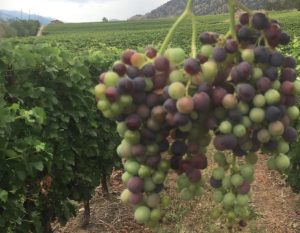 Véraison, the French viticulture term for the change of colour of the grapes, signifies an exciting time in the vineyard — the onset of ripening. Veraison represents the transition from berry growth to berry ripening, and many changes in berry development occur. In addition to the transition in colour from green to purple, throughout the process they also increase in volume, weight, sugar content and softness. After veraison, the berries are pliable, fruit acidity decreases and sweetness accumulates.
Véraison, the French viticulture term for the change of colour of the grapes, signifies an exciting time in the vineyard — the onset of ripening. Veraison represents the transition from berry growth to berry ripening, and many changes in berry development occur. In addition to the transition in colour from green to purple, throughout the process they also increase in volume, weight, sugar content and softness. After veraison, the berries are pliable, fruit acidity decreases and sweetness accumulates.
We saw veraison start in our Vanessa vineyard last month. Later in the ripening process flavour maturity will also take place with the formation of flavour and aroma compounds — or “phenolic ripeness”. (Phenols are complex molecules, including tannins, in the grape skins that can contribute bitter flavours. As grapes ripen, they change from green and bitter to pleasantly astringent, to soft and ripe-tasting.) The whole process takes about six weeks with the balance between sugar, acid, and flavour compounds ultimately determining the pick date.
The interval from veraison to harvest is naturally different for each varietal, and is primarily dependent on heat accumulation and crop size. Merlot for example takes fewer heat units to ripen than Cabernet Sauvignon. Knowing the ideal time to harvest begins with tasting. Our winemaker is looking for specific flavours in each variety. In addition to tasting the grapes, we measure sugar levels, pH and acidity to also help us determine when our fruit is ready to be picked.
So far for 2016, the vintage is looking great and we are excited for harvest later this fall. Renowned local Master of Wine Rhys Pender writes about the vintage:
“It was looking like 2016 might be one of those very hot (too hot) vintages as the early budbreak and then hot temperatures through April, May and most of June had grapes rushing towards ripeness. The growing degree days were ahead of any other year on record. Mother Nature then stepped in and July ended up being the fourth coolest in Summerland and the third coolest in Osoyoos since 1998. This welcome cool weather and some unseasonal rainfall really put the brakes on the ripening and probably turned the vintage from a potentially dangerously hot one to an almost ideal one. The grapes’ flavour complexity seems to develop more if the growing season is stretched out a bit longer, and the cool July helped to do just that. August saw temperatures back to their normal levels and ripening resumed at a steadier pace. Although temperatures cooled down in early September and there were a few showers and some worried farmers, things have picked up again and the forecast for the Okanagan and Similkameen valleys is sun and mid-to-high 20s for the next 10 days at least. That will make the vintage shape up very nicely indeed…” Read more of Rhys’s comments on the Wine Align website.